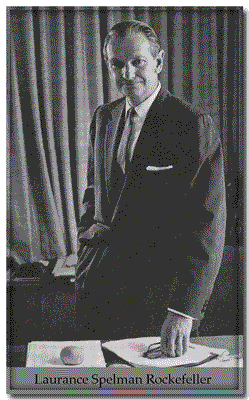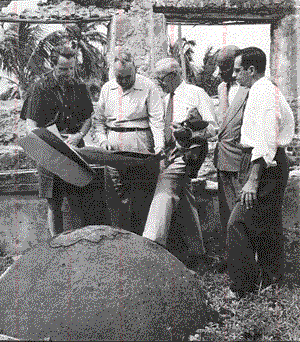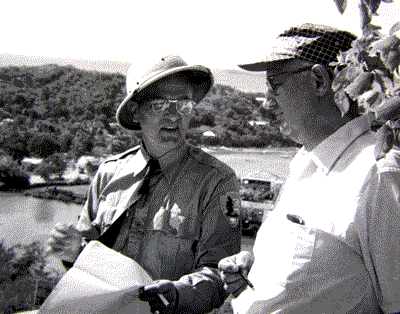Establishment of the Virgin Islands National Park (VINP)
(A summary of the February 14th, 2006 presentation by Bruce Schoonover)
This year being the 50th Anniversary of the VINP, it is a fitting time to recognize our nation’s 29th National Park.
Congress passed the enabling legislation for the establishment of the VINP on August 2, 1956, and it was signed into law by President Eisenhower. Primarily, it provided that a minimum of 5,000 acres would need to be acquired and turned over to the National Park Service, and that not more than 9,485 acres could be included within the boundaries of the park on St. John. St. John consists of approximately 12,800 acres, so approximately 3,000 acres was to be carved-out and reserved for private ownership.
The founders were adamant that the proposed park should not only benefit the nation as a whole, but should also benefit the locals, or natives, of the Island. It is for this reason that the population centers, Cruz Bay and Coral Bay, were to be outside the boundaries of the park. As the then St. John Senator to the Virgin Islands Legislature, Julius Sprauve, would state in a March 14, 1956 Daily News letter-to-the-editor piece, “the remaining 3,000 acres includes all established communities, ninety percent of all arable land, all present port or boat entries and those which might be used for such purposes in the future.”

On December 1, 1956, in a ceremony in the Cruz Bay Park that was attended by 900 people, Laurance S. Rockefeller formally presented the deeds to 5,086 acres of St. John land to Fred Seaton, Secretary of the Department of Interior and our nation’s 29th National Park was formally established. This seemingly culminated a two and one-half year process. However, a closer look at the records reveals that the genesis of the park had actually begun 20 plus years earlier.
As far back as the early 1930s, during the term of Dr. Paul Pearson, the first civilian Governor of the Virgin Islands, there was an interest in seeing St. John set aside as a park. Dr. Pearson recognized this as a way to build the tourist trade, and more importantly, help the economy. However, all these early efforts failed for a number of reasons, but it was certainly the turmoil in Europe in the late 1930s, and then the onset of World War II that would scuttle all efforts to establish a park in the 1940s.
Ultimately, there were at least four individuals who played pivotal roles in the establishment of the Virgin Islands National Park. They are:
Laurance S. Rockefeller (LSR), grandson of John D. Rockefeller, Sr. (founder of Standard Oil) and middle son of John D. Rockefeller, Jr. (whose credo was “I believe that every right implies a responsibility, every opportunity, an obligation every possession, a duty.”) Laurance became know for the Three c’s-capitalism, conservation and cancer research (the Rockefeller family instituted the first medical research center in the U.S in 1901.) In conservation, LSR and the Rockefeller family, worked closely with the NPS to preserve thousands of acres of land, and they gave millions of dollars in support of numerous programs initiated by the NPS. In 1991, LSR received the Congressional Gold Medal of Honor in recognition for his lifelong contribution to the environment.

Frank Stick, born in the Dakota Territory in 1884, was an accomplished illustrator, a conservationist and developer. He moved to the Outer Banks of North Carolina in the 1920s and was instrumental in having land set aside for the Wright Brothers Memorial, the Fort Raleigh National Historic Site and the Cape Hatteras National Seashore Park. He worked closely with the NPS in these efforts. (Pictured, l to r, LSR, Henry Beebe-construction eng. for LSR, Frank Stick, Sen. Julius Sprauve and Rev. George Starling, circa 1956.)
Conrad Wirth, who began his career with the NPS in 1931, became its Assistant Director, Branch of Lands, with responsibility for evaluating potential national parks, headed the CCC efforts for the NPS, and in 1939, requested an evaluation of St. John as a national park. In 1951, he became the Director of the NPS, and remained so until he retired in 1964.
Harold Hubler began his career with the NPS in 1934, was head of the CCC program in the VI in the 1930s, wrote a report on making Reef Bay a territorial park in 1938, and in 1939, produced a report on making St. John a National Park or Recreational Area. In the 1950s he would update the 1939 report, and in 1957, he became the VINP’s first Superintendent. (Harold Hubler is on the left and Conrad Wirth on the right, overlooking the Cruz Bay Battery, circa 1956)

Coincidently, Laurance Rockefeller and Frank Stick both made their way to St. John in 1952. Shortly thereafter, Laurance Rockefeller bought Caneel Bay Plantation, consisting of some 573 acres, and began renovation of the facility to make it his first environmentally-oriented resort.
About the same time, Frank Stick, along with four business partners, bought the Lameshur Estate consisting of 1,433 acres. They immediately began plans for also acquiring the Reef Bay estate and establishing a commercial venture on these properties. Within a year, Frank would abandon these plans in favor of proposing a National Park or Monument for St. John, as he had done earlier in the Outer Banks of NC. It is felt that his change of heart was due to a number of reasons, including: his age (70), his failing health (heart problems), realization of the effort and costs involved in achieving their objectives, and his son, David’s, lack of enthusiasm about the project.
On May 30, 1954, Frank Stick wrote an extensive letter to Archie Alexander, governor of the VI. At the same time, he proposed the park idea to LSR. It immediately resonated with LSR, and they agreed to meet. In September, meetings between LSR, Frank Stick, and Conrad Wirth were held, and it was agreed to proceed. LSR would fund and oversee the project, Allston Boyer, an associate of LSR, would assist on the project, Conrad Wirth would shepherd the necessary legislation through Congress, and Frank Stick would line up the options and purchase agreements for the land to be included within the park.
At a meeting in November 1954, Frank Stick surprised the group with the news that he had, in fact, obtained purchase options for sufficient property to achieve the minimum requirement of 5,000 acres. (Frank had done this at his own expense, and over the course of the next several years, consistently refused any compensation for his efforts in connection with the park.) The purchase options obtained by Stick were turned over to Jackson Hole Preserve, Inc. (JHPI) which would exercise the options on behalf of Laurance Rockefeller. It took the next two years to do so, negotiating purchase arrangements for additional properties, passing the required enabling legislation in the VI Legislature and in Congress, and finalizing the plans for our nation’s 29th National Park.
On December 1, 1956, in a ceremony in Cruz Bay Park, Laurance Rockefeller, on behalf of JHPI, turned over the deeds to 5,086 acres of land on St. John to Fred Seaton, Secretary of Interior. At this ceremony, it was reported that when Laurance Rockefeller got up to present the deeds, many of the local people got up and clapped and shouted “God bless Mr. Rockefeller”. This fact was reported in a letter from Conrad Wirth to John D. Rockefeller, Jr. It appears that this was a sentiment that was widely held at the time. St. John Senator, Julius Sprauve, stated in a letter to the editor, in March 1956, the following:
“While the name of Laurance Rockefeller is mentioned in connection with the proposed national park, his past and proposed future benefactions have been too lightly dwelt upon. No man knows better than the writer, what Mr. Rockefeller’s efforts so far have meant to people of St. John. I can state with complete conviction that during the past year and more, as the sole result of this generous and far seeing man’s efforts, our people have enjoyed greater prosperity than at any time in the memory of our oldest inhabitants. And without these efforts, many of our people would have been in a condition approaching destitution and many would have been forced to seek precarious employment in distant lands, as has been the unhappy rule in years gone by.”
According to records obtained from the Rockefeller Archive Center, JHPI paid a total of $962,100 for this initial acreage… or about $189 per acre. Following is a list of the parties that provided the initial land for the VINP:
Emily Creque----------------------719 acres Frank Stick and partners----1,437 acres H.E. Lockhart Development Corp----843 Irving J. Backer -------------374 Frank R. Faulk--------------------651 Julius Sprauve----------------225 Halvor Neptune Richards------------54 Claudia Joshua----------------150 Ralf Hartwell Boulon---------------59 Leonard and Silvia Cox---------17 Gehardt Sprauve--------------------39 Agnes and John Butler----------57 Julia Chanler Laurin---------------40 Laurance S. Rockefeller-------421
In a May 23, 1958 letter to Frank Stick, Laurance Rockefeller would confirm Frank Stick’s contribution to the park effort. In part, it states:
“… I greatly appreciate your outstanding contributions to the Virgin Islands National Park project. The gift of approximately $50,000 to the Jackson Hole Preserve, Inc., representing your share of the Lameshur land, was not only a generous gesture on your part but was a tangible evidence of your deep interest in the park project. You have undertaken this as a volunteer and you have consistently resisted our efforts to reimburse you for the enormous amounts of time and effort you have put into this project. Since that day many years ago when you brought the Hubler report to my attention and offered your lands, we have seen the project become a reality. I am sure that this achievement will be a lasting satisfaction to you. The Virgin Islands National Park will in the years to come mean more and more to people there and those who come to the Virgin Islands from all parts of the globe, in keeping with the hopes and expectations expressed at the time of its inception.”
[Dr. Paul Pearson][Rockefeller, Laurance][Stick, Frank][VINP]
